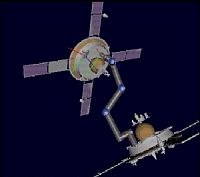Path planning for free-floating robots – from local workspace to global workspace


The path planning method developed to date involves an optimization algorithm which, to minimize the spacecraft fuel expenditure, makes full use of the free-floating robot dynamics. Free-flying robots will eventually have to move out of their free-floating status, for which the base body is not actuated, to be able to reach points outside of their local workspace. An example of a maneuver in the local workspace is given in the first video below. The video shows the pronounced dynamic coupling between the robot and the chaser spacecraft.
If the initial position of the robot is such that the desired end position of the end-effector is out of the reach of the robot, an extra spacecraft maneuver is necessary. This example is show in the second video below.
The solution shown in the second video has been optimized for the energy of the spacecraft. This makes use of a base solution provided by the free-floating dynamics of the system and of an additional term to allow for adjustments in the spacecraft motion to reach the final destination.
